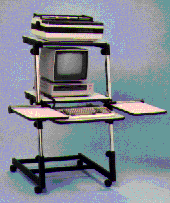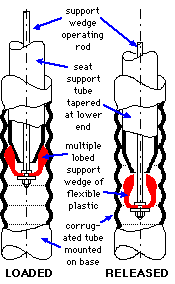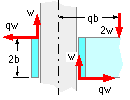Appendix A - "Improvements" to a computer workstation

The 'CompuChamp' is an easily moved workstation for microcomputers. It consists essentially of two load-bearing inclined uprights rigidly attached to a base equipped with castors, together with various tables and trays for monitor, keyboard, printer paper, desktop and other equipment.
 Tables are attached to sleeves which can slide up and down the uprights, and which are locked by hand-operated screws tightened to bear on the uprights. A user selects the tables required, adjusts their height, and locks them in position before finally placing equipment on them. The workstation can then be moved easily around as a complete unit.
Tables are attached to sleeves which can slide up and down the uprights, and which are locked by hand-operated screws tightened to bear on the uprights. A user selects the tables required, adjusts their height, and locks them in position before finally placing equipment on them. The workstation can then be moved easily around as a complete unit.
The need for improvement arose from an increasing awareness of repetitive strain injury (RSI) in the workforce at the time, which led to a market requirement for table heights to be adjustable under load, ie. after equipment had been placed on the tables. Without improvement it is virtually impossible for an unaided person to adjust the height of a loaded table - even although the load by itself is within the strength capabilities of that person, the necessity for supporting the load whilst simultaneously releasing two locking screws, adjusting the table to the desired height, and then relocking the screws, renders the whole procedure too dangerous (imagine yourself in the adjuster's shoes!). So the CompuChamp's manufacturer approached students to put forward ideas - ie. to prepare feasibility studies - for improving the workstation by permitting on-load table height adjustment. Students' responses were not accepted - admittedly it was not an easy brief (but then they never are !); it is instructive to learn by their mistakes.
It is very poor design to rely on friction as the major load support mechanism. As sure as fate, someone somewhere will at sometime leave a screw somewhat untightened; a slight knock could then easily cause the table to slip and a falling computer to inflict injury. This is Murphy again - things are fine for 99.99% of the time, but it is not difficult to foresee what can happen and design it out before being landed with a hefty damages claim - it is the designer's responsibility.

To drive this point home, consider the adjustable office chair whose mechanism's essentials are sketched in both the loaded position (when someone is sitting on the seat) and released to enable seat height adjustment. Not shown are various springs &c which cause the lobes to automatically spring back into engagement with the corrugations when the operating rod is deactivated after adjustment has been completed and the chair is again ready to support an occupant. The mechanism is ingenious as operation of the multiple lobed support wedge is not affected by heavier users - it is perfectly secure once properly engaged in the corrugations.
However one day a particular chair collapsed when someone sat on it after adjustment and received serious and permanent spinal damage. Collapse was due to a number of factors which prevented the lobes from re-engaging the corrugations when the occupant deactivated the operating rod, so the support wedge remained in the released mode and the mechanism descended too quickly under the occupant's weight for the lobes to engage lower down. A rare occurrence perhaps, but certainly foreseeable - it wasn't fail-safe.
Returning to the 'CompuChamp', its reliance on friction though poor enough when table heights are adjusted once only prior to loading, could be disastrous if adjustments were carried out on a routine basis. But there are further features which prevent easy improvement as desired.
 The side sectional view of an unlocked sleeve with cantilevered load 2w is sketched. The geometry is characterised by the single parameter q - the ratio between the load offset and half the sleeve depth, b. For the sleeve to remain in equilibrium the upright must exert force components w and qw on it at each of the two contact points as shown.
The side sectional view of an unlocked sleeve with cantilevered load 2w is sketched. The geometry is characterised by the single parameter q - the ratio between the load offset and half the sleeve depth, b. For the sleeve to remain in equilibrium the upright must exert force components w and qw on it at each of the two contact points as shown.
If the coefficient of friction between sleeve and upright is m then equilibrium is possible and slip avoided provided mq ≥ 1, no matter how big the load - indeed it is possible to sit on a 'CompuChamp's table with the locking screws completely removed ! But of course if while sitting, one were to move to reduce the load offset q, then the table would plunge - and the same capricious behaviour could occur if equipment were to be moved around on an improperly locked table.

This principle is used to advantage in an adjustable clamp which can be adjusted before tightening, and where q is large and fixed. It is distinctly disadvantageous in the 'CompuChamp' however, because jamming will occur if the load is offset by more than b/m. This behaviour means that support of a load in a manner which promotes free sliding can occur reliably only if the reaction is approximately coaxial with the load (ie. q < 1/m ) - any other location leads to a couple and potential jamming. It may be appreciated that it is difficult to provide a height- adjusting drive to a table which is coaxial with the load rather than along the uprights.
Jamming is promoted also by the twin uprights.
 The front view shows a table's two sleeves in contact with the uprights at two discrete points due to an asymmetric table-tipping load. A couple similar to that above is created and leads to binding. The table can be moved only through synchronised equal displacements of the two sleeves - a mechanism to carry this out, though not particularly complex in itself, could be expected to be awkward to incorporate retrospectively into the existing design. Binding on the two uprights is exacerbated by inaccurate manufacture when a number of tables with slightly different sleeve spacing are assembled onto a pair of uprights.
The front view shows a table's two sleeves in contact with the uprights at two discrete points due to an asymmetric table-tipping load. A couple similar to that above is created and leads to binding. The table can be moved only through synchronised equal displacements of the two sleeves - a mechanism to carry this out, though not particularly complex in itself, could be expected to be awkward to incorporate retrospectively into the existing design. Binding on the two uprights is exacerbated by inaccurate manufacture when a number of tables with slightly different sleeve spacing are assembled onto a pair of uprights.
The students who tackled this 'improvement' problem missed the above points. They carried out paper exercises without paying enough (any?) attention to the real world, though they were provided with a 'CompuChamp', on which to experiment had they wished. It is concluded that the 'CompuChamp', though commercially successful when tables are loaded only after adjustment, is not suitable for modifications which permit routine on-load adjustment.
The moral here ? Beware the improvement brief :
'Improve the present design'
really means
'Select the optimum solution to suit criteria which differ from those for which the present design is optimum'
 Copyright 1999-2005 Douglas Wright
Copyright 1999-2005 Douglas Wright
last updated May 2005
 Tables are attached to sleeves which can slide up and down the uprights, and which are locked by hand-operated screws tightened to bear on the uprights. A user selects the tables required, adjusts their height, and locks them in position before finally placing equipment on them. The workstation can then be moved easily around as a complete unit.
Tables are attached to sleeves which can slide up and down the uprights, and which are locked by hand-operated screws tightened to bear on the uprights. A user selects the tables required, adjusts their height, and locks them in position before finally placing equipment on them. The workstation can then be moved easily around as a complete unit.


 The side sectional view of an unlocked sleeve with cantilevered load 2w is sketched. The geometry is characterised by the single parameter q - the ratio between the load offset and half the sleeve depth, b. For the sleeve to remain in equilibrium the upright must exert force components w and qw on it at each of the two contact points as shown.
The side sectional view of an unlocked sleeve with cantilevered load 2w is sketched. The geometry is characterised by the single parameter q - the ratio between the load offset and half the sleeve depth, b. For the sleeve to remain in equilibrium the upright must exert force components w and qw on it at each of the two contact points as shown.

 The front view shows a table's two sleeves in contact with the uprights at two discrete points due to an asymmetric table-tipping load. A couple similar to that above is created and leads to binding. The table can be moved only through synchronised equal displacements of the two sleeves - a mechanism to carry this out, though not particularly complex in itself, could be expected to be awkward to incorporate retrospectively into the existing design. Binding on the two uprights is exacerbated by inaccurate manufacture when a number of tables with slightly different sleeve spacing are assembled onto a pair of uprights.
The front view shows a table's two sleeves in contact with the uprights at two discrete points due to an asymmetric table-tipping load. A couple similar to that above is created and leads to binding. The table can be moved only through synchronised equal displacements of the two sleeves - a mechanism to carry this out, though not particularly complex in itself, could be expected to be awkward to incorporate retrospectively into the existing design. Binding on the two uprights is exacerbated by inaccurate manufacture when a number of tables with slightly different sleeve spacing are assembled onto a pair of uprights.